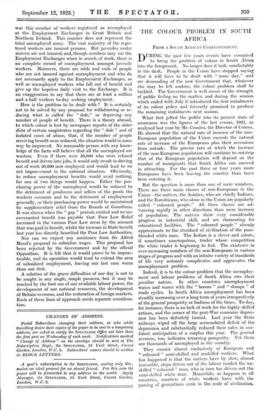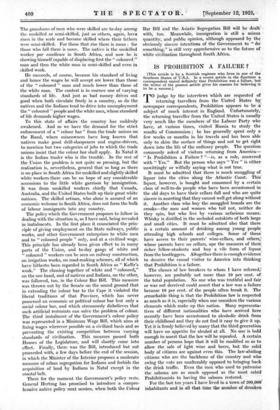THE COLOUR PROBLEM IN SOUTH AFRICA
FROM A SOUTH AFRICAN CORRESPONDENT.
DURING the past few years events have conspired to bring the problem of colour in South Africa into the foreground. No longer does it lurk comfortably in the dark. People in the Union have stopped saying that it will have to be dealt with " some day," and are demanding of the new Government that, whatever else may be left undone, the colour problem shall be tackled. The Government is well aware of the strength of public feeling on the matter, and during the session which ended with July it introduced the first instalments of its colour policy and fervently promised to produce the remaining instalments next session.
What first jolted the public into its present state of awareness was the figures of the last census, 1921, as analysed last year by Mr. Cousins, the Director of Census. He showed that the natural rate of increase of the non- European population of the Union exceeds the natural rate of increase of the Europeans plus their accessions from outside. The precise rate at which the increase of the non-European population will continue to outstrip that of the European population will depend on the number of immigrants that South Africa can succeed in attracting. For the past three or four years more Europeans have been leaving the country than have been entering it.
But the question is more than one of mere numbers. There are three main classes of non-Europeans in the Union—the natives, the Asiatics, who are chiefly Indians, and the Eurafricans, who alone in the Union are popularly called " coloured people." All three classes are ad- vancing rapidly in other directions than mere increase of population. The natives show very considerable progress in industrial skill, and are clamouring for educational facilities. The " coloured people " already approximate to the standard of civilization of the pure- blooded white man. The Indian is a clever and astute, if sometimes unscrupulous, trader whose competition the white trader is beginning to feel. The existence in ever-increasing numbers of the non-Europeans in various stages of progress and with an infinite variety of standards of life very seriously complicates and aggravates the unemployment problem.
Indeed, it is to the colour problem that the unemploy- ment and labour problems of South Africa owe their peculiar nature. In other countries unemployment waxes and wanes with the " booms " and " slumps " of trade cycles. In South Africa unemployment has been steadily increasing over a long term of years irrespectively of the general prosperity or badness of the times. To-day, for instance, there is no lack of work for the highly skilled artisan, and the corner of the post-War economic depres- sion has been definitely turned. Last year the State railways wiped off the large accumulated deficit of the depression and substantially reduced their rates in con- fident anticipation of a surplus this year. The general revenue, too, indicates returning prosperity. Yet there are thousands of unemployed in the country.
They consist almost exclusively of European and " coloured " semi-skilled and unskilled workers. What has happened is that the natives have by slow, almost insensible, steps driven out of the labour market the un- skilled " coloured " man, who in turn has driven out the semi-skilled white man. Meanwhile, as happens in all countries, numbers of white workers have with the passing of generations sunk in the scale of civilization. The grandsons of men who were skilled arc to-day among the unskilled or semi-skilled, just as- others, again, have risen in the scale and become skilled where their fathers were semi-skilled. For those that rise there is room : for those who fall there is none. The native is the unskilled worker par excellence in South Africa, and now he is showing himself capable of displacing first the " coloured " man and then the white man in semi-skilled and even in skilled work.
He succeeds, of course, because his standard of living and hence the wages he will accept are lower than those of the " coloured " man and much lower than those of the white man. The contest is in essence one of varying standards of life. And just as bad money drives out good when both circulate freely in a country, so do the natives and the Indians tend to drive into unemployment the " coloured " people and the white men, whose standard of life demands higher wages.
To this state of affairs the country has suddenly awakened. And so we have the demand for the strict enforcement of a " colour bar " from the trade unions on the Rand, where mineowners have long known that natives make good drill-sharpeners and engine-drivers, to mention but two categories of jobs to which the trade unions insist that the colour bar shall apply. In Natal it is the Indian trader who is the trouble. In the rest of the Union the problem is not quite so pressing, but the realization is, nevertheless, general that so long as there is no place in South Africa for unskilled and slightly skilled white workers there can be no hope of any considerable accessions to the little white garrison by immigration. It was from unskilled workers chiefly that Canada, Australia, and the United States built up their great white nations. The skilled artisan, who alone is assured of an economic welcome in South Africa, does not form the bulk of labour immigrants into any country.
The policy which the Government proposes to follow in dealing with the situation is, as I have said, being revealed in instalments. In the first place it enunciated the prin- ciple of giving employment on the State railways, public works, and other Government enterprises to white men and to " coloured people " only, and at a civilized wage.
This principle has already been given effect to in many parts of the Union, and to-day gangs of white and " coloured " workers can be seen on railway construction, on irrigation works, on road-making schemes, all of which have hitherto been regarded in South Africa as " Kaffir's work." The classing together of white and "coloured," on the one hand, and of natives and Indians, on the other, was followed, too, in the Colour Bar Bill. This measure was thrown out by the Senate on the sound ground that in extending the colour bar to the Cape it violated the liberal traditions of that Province, which has never possessed an economic or political colour bar but only a social colour bar, and which strenuously disbelieves that such artificial restraints can solve the problem of colour.
The third instalment of the Government's colour policy was represented in a Minimum Wage Bill, which aims at fixing wages wherever possible on a civilized basis and so preventing the existing competition between varying standards of civilization. This measure passed both HouSes of the Legislature, and will shortly come into effect. Finally, there was the Bill, introduced but not proceeded with, a few days before the end of the session, in which the Minister of the Interior proposes a moderate measure of urban segregation for Indians and forbids the acquisition of land by Indians in Natal except in the coastal belt.
There for the moment the Government's policy rests. General Hertzog has promised to introduce a compre- hensive native policy -next session, when both the Colour Bar Bill and the Asiatic Segregation Bill will be dealt with, too. Meanwhile, immigration is still a minus • quantity, and public opinion, although appeased by the - obviously sincere intentions of the Government to " do' something," is still very apprehensive as to the future of white civilization throughout South Africa.











































 Previous page
Previous page